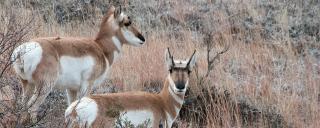
Pronghorn Habitat
General Information
Pronghorn are resilient wild ruminants native to North America. Pronghorn are the only surviving member of their family and are neither antelopes nor goats. One of the most unique characteristic of pronghorn is their horns. They have pseudohorns, the core covered by a black sheath made of cells similar to skin. Pronghorn are the only ungulate in the world that annually shed the horn sheath. Historically, pronghorn were abundant in North America and occupied all of North Dakota before becoming nearly extirpated by the late 1800s. Unregulated hunting, conversion of native prairie to annual crop production, and construction of fences by European settlers resulted in only a few hundred pronghorn remaining in the state by 1920. Pronghorn numbers rebounded by the early 1960s after the regulation of hunting and translocation of animals from Montana in the 1950s. Today, pronghorn are primarily distributed across western North Dakota, although small numbers do exist east of the Missouri River. Pronghorn have exceptional speed and eyesight.
General Habitat Requirements
Pronghorn use open and arid landscapes. They are associated with sagebrush and grassland communities in western North Dakota. Pronghorn have proven to be adaptable to the available landscape in the state, by making use of available CRP grass plantings. Pronghorn are opportunistic foragers that consume forbs, shrubs and grasses depending on availability and nutritional status. They also take advantage of nontraditional food sources found in North Dakota such as cereal grains, corn, sunflowers and alfalfa. Pronghorn have adapted to arid environments by being water conservers. They fulfill water needs through a variety of sources, such as streams, lakes, stock tanks, dug-outs, rain, snow and dew, as well as water in forage. Cover for pronghorn is provided by either topography or vegetation. Pronghorn use leeward sides of hills and buttes to find refuge from high winds and deep snow. Pronghorn will bed beneath trees and tall shrubs during periods of extreme heat. Females use shrub and grasslands with vegetative structure that provides concealment for newborn kids and forage for the doe.
Management Considerations
- Incorporate prescribed grazing plans that encourage a diverse landscape of grasses, shrubs and forbs.
- Preserve native prairie. It is not recommended to convert native prairie for wildlife food plots, introduced grass species, trees, etc.
- Consider not grazing or using light cattle stocking rates during mid-April to mid-June for pastures known to be used for pronghorn fawning.
- Replace barbed wire with smooth wire, if possible, and consider changing heights of bottom wire to 16-18 inches. Control tall woody vegetation, including single trees that act as raptor perches and raptor nest sites.
- If four-strand wire fences are being constructed, the bottom wire should be smooth and placed 16-18 inches above the ground to allow pronghorn to move under the bottom wire. Six to 12-foot sections of PVC pipe can also be placed on various sections of fence to allow pronghorn to move under the bottom wire.
- If three-strand wire fences are being constructed, the bottom wire should be smooth and placed 16-18 inches above the ground to allow pronghorn to move under the bottom wire, with a maximum fence height of 42 inches.

